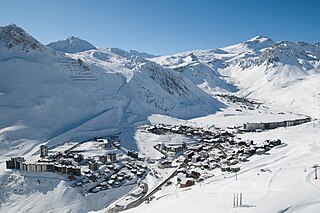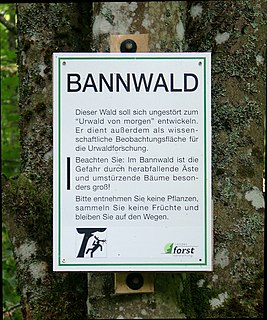Related Research Articles

A dam is a barrier that stops or restricts the flow of water or underground streams. Reservoirs created by dams not only suppress floods but also provide water for activities such as irrigation, human consumption, industrial use, aquaculture, and navigability. Hydropower is often used in conjunction with dams to generate electricity. A dam can also be used to collect water or for storage of water which can be evenly distributed between locations. Dams generally serve the primary purpose of retaining water, while other structures such as floodgates or levees are used to manage or prevent water flow into specific land regions. The earliest known dam is the Jawa Dam in Jordan, dating to 3,000 BC.

An avalanche is an event that occurs when a cohesive slab of snow lying upon a weaker layer of snow fractures and slides down a steep slope. Avalanches are typically triggered in a starting zone from a mechanical failure in the snowpack when the forces of the snow exceed its strength but sometimes only with gradual widening. After initiation, avalanches usually accelerate rapidly and grow in mass and volume as they entrain more snow. If the avalanche moves fast enough, some of the snow may mix with the air forming a powder snow avalanche, which is a type of gravity current.
In electronics, an avalanche diode is a diode that is designed to experience avalanche breakdown at a specified reverse bias voltage. The junction of an avalanche diode is designed to prevent current concentration and resulting hot spots, so that the diode is undamaged by the breakdown. The avalanche breakdown is due to minority carriers accelerated enough to create ionization in the crystal lattice, producing more carriers which in turn create more ionization. Because the avalanche breakdown is uniform across the whole junction, the breakdown voltage is nearly constant with changing current when compared to a non-avalanche diode.

Rogers Pass is a high mountain pass through the Selkirk Mountains of British Columbia used by the Canadian Pacific Railway and the Trans-Canada Highway. The pass is a shortcut across the "Big Bend" of the Columbia River from Revelstoke on the west to Donald, near Golden, on the east. The pass was discovered on May 29, 1881, by Major Albert Bowman Rogers, a surveyor working for the Canadian Pacific Railway. A second pass was named for Rogers in 1887 in Montana, c.373 miles to the south-east.

Backcountry skiing (US), also called off-piste (Europe), alpine touring, or out-of-area, is skiing in the backcountry on unmarked or unpatrolled areas either inside or outside a ski resort's boundaries. This contrasts with alpine skiing which is typically done on groomed trails benefiting from a ski patrol. Unlike ski touring, backcountry skiing can include the use of ski lifts including snowcats and helicopters. Recent improvements in equipment have increased the popularity of the sport.

A spillway is a structure used to provide the controlled release of flows from a dam or levee into a downstream area, typically the riverbed of the dammed river itself. In the United Kingdom, they may be known as overflow channels. Spillways ensure that the water does not overflow and damage or destroy the dam.

Tignes is a commune in the Tarentaise Valley, in the Savoie department in the Rhône-Alpes region in south-eastern France, known for the highest skiable area in Europe and the longest ski season in Europe. It is located in the Savoie region with good transport links in and out of Lyon, Geneva and Chambery.

A rockfall or rock-fall refers to quantities of rock falling freely from a cliff face. The term is also used for collapse of rock from roof or walls of mine or quarry workings. A rockfall is a fragment of rock detached by sliding, toppling, or falling, that falls along a vertical or sub-vertical cliff, proceeds down slope by bouncing and flying along ballistic trajectories or by rolling on talus or debris slopes,”. Alternatively, a "rockfall is the natural downward motion of a detached block or series of blocks with a small volume involving free falling, bouncing, rolling, and sliding". The mode of failure differs from that of a rockslide.

A snow shed, snow bridge or avalanche gallery is a type of rigid snow-supporting structure for avalanche control or to maintain passage in areas where snow removal becomes almost impossible. They can be made of steel, prestressed concrete frames, or timber. These structures can be fully enclosed, like an artificial tunnel, or consist of lattice-like elements. They are typically of robust construction considering the environments they must survive in.

Mount Colden is the eleventh-highest peak in the High Peaks of the Adirondack Mountains, New York, United States. The peak was named after David S. Colden, an investor in the McIntyre Iron Works, in 1836. The peak was briefly renamed "Mount McMartin" the next year, but the older name persisted. The mountain is known for its distinctive Trap Dike, a large crevice running up the center of the mountain, which can clearly be seen from Avalanche Lake.

Flateyri is a village situated in Iceland's Westfjords. With a population of approximately 200, it is the largest settlement in Önundarfjörður.

An embankment dam is a large artificial dam. It is typically created by the placement and compaction of a complex semi-plastic mound of various compositions of soil, sand, clay, or rock. It has a semi-pervious waterproof natural covering for its surface and a dense, impervious core. This makes such a dam impervious to surface or seepage erosion. Such a dam is composed of fragmented independent material particles. The friction and interaction of particles binds the particles together into a stable mass rather than by the use of a cementing substance.
Avalanche nets are flexible snow supporting structures for avalanche control, constructed of steel or nylon cables or straps held by steel poles, optionally supplied with compression anchors downhill. They are installed in the upper parts of potential avalanche paths to prevent snow from starting to slide into an avalanche, or to retard the slide.

Avalanche control or avalanche defense activities reduce the hazard avalanches pose to human life, activity, and property. Avalanche control begins with a risk assessment conducted by surveying for potential avalanche terrain by identifying geographic features such as vegetation patterns, drainages, and seasonal snow distribution that are indicative of avalanches. From the identified avalanche risks, the hazard is assessed by identifying threatened human geographic features such as roads, ski-hills, and buildings. Avalanche control programs address the avalanche hazard by formulating prevention and mitigation plans, which are then executed during the winter season. The prevention and mitigation plans combine extensive snow pack observation with three major groups of interventions: active, passive and social - sometimes more narrowly defined as "explosive", "structural", and "awareness" according to the most prevalent technique used in each. Avalanche control techniques either directly intervene in the evolution of the snow pack, or lessen the effect of an avalanche once it has occurred. For the event of human involvement, avalanche control organizations develop and train exhaustive response and recovery plans.
A landslide dam or barrier lake is a natural damming of a river by some kind of landslides, such as debris flows and rock avalanches, or by volcanic eruptions. If the damming landslides are caused by an earthquake, it may also be called a quake lake. Some landslide dams are as high as the largest existing artificial dam.

The Val Pola landslide happened in Valtellina, Lombardy, Northern Italian Alps, on July 28, 1987 and resulted in the Valtellina disaster with the total cost of 400 million euros. The calamity affected the provinces of Sondrio, Brescia, Bergamo, Lecco, and Como.
The Kundah Hydro-electric Power Scheme is located in the Nilgiris, Tamil Nadu, India. It is the one of the biggest electricity generating schemes in Tamil Nadu. The group of peaks Devarbatta, Karaikada, Koulingabetta and Porthimund, all over 2400 Metres ASL drain into two streams, Avalanche and Emerald. Avalanche and Emerald Dams, along with Upper Bhavani, form the major source of water for the Kundah hydro-electric project. The project is a symbol of India-Canada friendship and co-operation. The project was executed by then TNEB Civil engineer R.S. Sankaranarayanan (Retd.), who now resides in Vanandurai, Besant Nagar, Chennai The Power houses were commissioned from the year 1960 to 1964.

Bannwald is a German word used in parts of Germany and Austria to designate an area of protected forest. Its precise meaning has varied by location and over time.

A Steilhang is a geoscientific term for a steep mountainside or hillside, the average slope of which is greater than 1:2 or 30°. Leser defines a steilhang as a mountainside with an incline of between 16° and 60°, slopes of between 30° and 60° being described as "very steep" (übersteil) and anything over 60° being a rock face (wand).